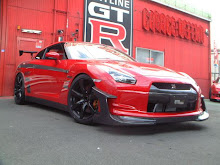
There are some cars which look 'hard' but are in actual fact, pussycats under the hood. These are the cars which leave me feeling empty inside. These are the cars which enrage me. These are the cars which disgust me.
This DC5 looks 'hard' in a very subtle way. It's menacing black paint scheme and dark bronze wheels make the car blend in just as much as it stands out. The restrained paint job doesn't show off the bodykit's lines which gives the car its subdued and restrained appearance. This car is a paradox, I tell ya.
What separates this car from the rest is just how 'hard' it really is underneath its restrained looks. Under the hood, you'll find just about every part that can be fitted to the famed K20A. And the sound that this Integra makes at idle is one of the meanest four cylinder rumbles man has ever heard.
This engine bay defines the term 'built'. Almost nothing of the standard K20A remains. What makes this engine build so different from the others is that this K20A was built by Mr. Toon of Thailand, one of South East Asia's most renowned engine builders. Mr. Toon is one hard individual to please, as he is very meticulous when it comes to his engine builds, but it's because of this 'anal' nature that Mr. Toon has built such a reputable name for himself. When he builds his engines, he builds them to last, and this car has been driven up and down the Asian continent, from KL to Vietnam more than once, without a single hiccup.
Pry open the valve cover and you'll see Toda Spec C camshafts which push down on Crower oversized valves. The valves are held in place with JUN valve guides, Crower titanium retainers and Toda valve springs. Toda's VTC (or variable valve timing) killer cam sprockets replace the original sprockets as the variable timing system is more suited for the stock camshafts. With the higher profile and duration Toda Spec C camshafts, the variable timing system would have limited the amount of power that the Toda cams would unlock.
The head now is fastened more securely to the block with ARP head studs and sandwiched in between the head and block is a more durable Toda High Power head gasket to cope with the increased cylinder pressures brought upon by the forged high compression pistons from the Toda 2157cc stoker kit.
This stroker kit includes a fully balanced crankshaft, forged pistons, forged conrods, and conrod bearings. The 2157cc kit requires boring the cylinders out to 87mm from 86mm and the pistons have a high static compression ratio of 12.3:1; a volatile situation for any engine. Stroke is increased from 86mm to 90.7mm as well, which helps with torque production.
Freeing up the K20A's intake is a HKS Super Power Flow air filter and a Toda oversized throttle body. The restrictive factory exhaust was also replaced with a Toda exhaust manifold and a Buddy Club Spec III exhaust system, and it is LOUD. Extra fuel is needed for an engine built this extensively, so holding up that end of the stick is a Walbro fuel pump, a Golden Eagle fuel rail and RC Engineering 440cc injectors.
This car really proves that you can build an extreme car while being under the radar. One would never expect such a monster of an engine inside a car which looks as sedate as this. This is how cars should be built and modified, they should look hard and go hard, and be driven hard.










































































